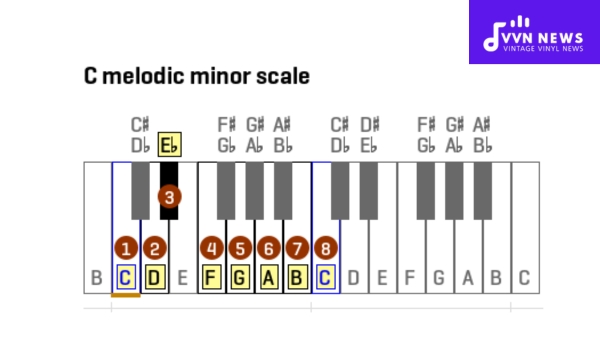The C melodic minor scale can truly unlock a new dimension in your musical journey. The C melodic minor scale is not just another sequence of notes to memorize.
It’s a go-to tool for many musicians, instrumentalists, and composers alike who are looking to infuse their pieces with a touch of expressiveness and depth.
Now, I know the mere mention of musical scales might seem straightforward to some while intimidatingly complex to others. But don’t worry!
My goal here is to break down this intriguing scale into bite-size portions that make it easier for you to comprehend and apply in your own music creations or practice sessions.
The Intervals that Make Up the C Melodic Minor Scale
There’s something distinctive and alluring about the C Melodic Minor Scale. It is a unique blend of intervals that are delicately sewn together.
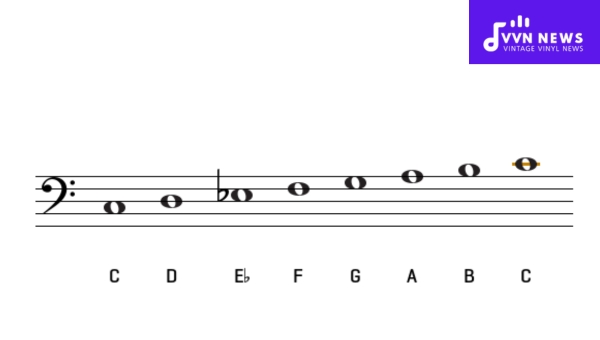
When we paint this musical landscape ascending, each stroke is defined by specific intervals: it begins with a Tone (T), follows with a Semitone (S), then four continuous tones (T), and tops off with a final semitone (S).
Outlining it in notes:
- C to D: A full Tone leap
- D to Eb: A half-step Semitone
- Both Eb to F and F to G are Tones.
- We conclude on an uplifting note where G to A, A to B, and 7. B back to C occupy our crescendo as pure ascending Tones.
To put it otherwise:
- From the root or 1st degree (C) to Major 2nd (D)
- From Major 2nd (D) to Minor 3rd (Eb)
- Ascending from Minor 3rd (Eb) through Perfect 4th (F) and Perfect 5th (G)
- And finally transcending from Major 6th (A), through Major 7th (B), until we’re back home at C.
This interesting interplay of intervals exudes charm and finesse, making it an integral part of various compositions.
Also Read: How To Transpose Music? [Simplifying Key Changes In Songs]
How is a melodic minor scale constructed?
The beauty of the melodic minor scale lies in its unique structure. It’s essentially an amalgamation of two contrasting parts, delivering diversity that’s both engaging and intriguing.
You’ll find, while ascending, it’s just like any standard minor scale but with the sixth and seventh notes altered.
Created by taking a straightforward natural (or pure) minor scale and raising the sixth and seventh notes – hence giving it more melodic appeal (essential for those exquisite harmonies we all love).
Whereas descending, it quickly morphs back into a natural minor format.
This simply means starting from the top-hand side, you let the sixth and seventh notes rest in their original ‘minor’ placement.
It’s almost like experiencing two distinct scales cleverly infused into one!
scale degrees ascending in C melodic minor
The ascending degrees of the C Melodic Minor scale each have their unique names and functions. Let me guide you through them:
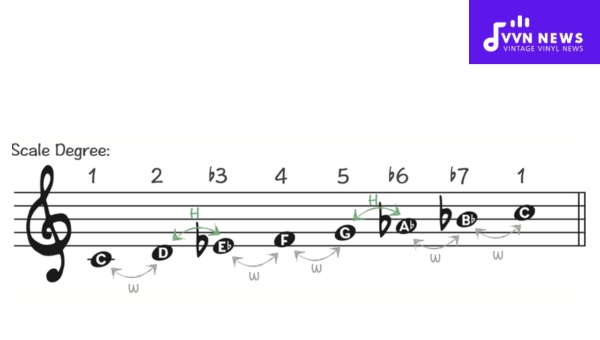
- 1st Degree – The Root/Tonic – C: This is the foundation, where it all starts. It sets the tonal center of the scale.
- 2nd Degree – The Supertonic – D: This provides tension that often leads back to the root or forward to the mediant.
- 3rd Degree – Mediant – Eb: It mediates between the tonic and dominant, it acts as a bridge in a sense.
- 4th Degree – Subdominant – F: Often used to contrast with the tonic, introducing an element of surprise into your compositions.
- 5th Degree – Dominant – G: One of the most important degrees, this establishes tonality and often resolves to the tonic.
- 6th Degree – Submediant – A: It’s functionally versatile depending on its usage.
- 7th Degree – Leading Note – B: As its name implies, this note “leads” us back to the root during an ascent.
Discovering these essential aspects of musical scales will help you comprehend their patterns and complexities better.
They can open up an amazing world of creativity when applied correctly, making your music sound more sophisticated and professionally layered.
Scale Degrees Descending in C Melodic Minor
Playing the descending C melodic minor scale is typically more straightforward because here, the scale mirrors the natural minor scale. The notes run from high to low as follows:
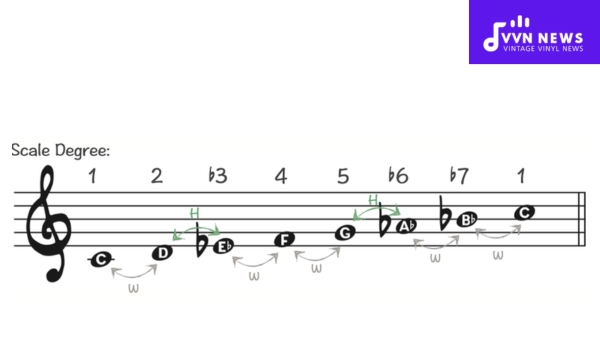
- 7th Degree – Leading Note – B
- 6th Degree – Submediant – A
- 5th Degree – Dominant – G
- 4th Degree – Subdominant – F
- 3rd Degree – Mediant – Eb
- 2nd Degree – Supertonic – D
- 1st Degree – Root/Tonic – C
To simplify this further, imagine standing at the top of a staircase and stepping down each stair represents moving to the next degree in your scale.
When you get to the bottom, you’ve played a full descending C Melodic Minor scale!
Also Read: F Sharp Major Triad [Enhance Your Musical Compositions]
Playing C Melodic Minor on Different Instruments
Learning to play the C melodic minor scale on any instrument can open up a new realm of nuance and expression in your music.
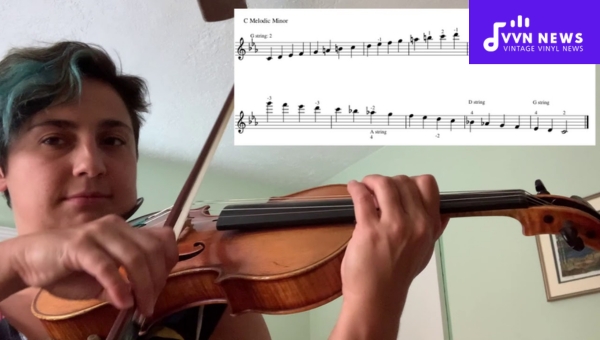
Let’s delve into the nuts and bolts of playing this scale on different instruments.
Piano:
Playing the C Melodic Minor scale on the piano is a tactile experience that helps you literally feel the music under your fingers. Here are the steps:
- Start with your thumb (1st finger) on Middle C.
- Use your index finger (2nd finger) to play D.
- Play E-flat with your third finger (middle).
- Reach your thumb under to play F.
- Continue with G, A, and B using your second, third, and fourth fingers respectively.
- Finally, use your fifth finger (little finger) to play C.
The descending scale follows the natural minor scale instead of the melodic minor. That means you’ll be playing B-flat and A-flat instead of B and A.
Guitar:
Playing the C Melodic Minor scale on the guitar is a bit different due to its string configuration. Start on the 8th fret of the low E string (which is C) and follow this pattern:
- Low E string: 8th Fret (C), 10th Fret (D)
- A string: 7th Fret (E flat), 8th Fret (F)
- D String: 7th Fret (G), 9th Fret (A)
- G String: 7th Fret (B)
- After reaching B, shift position to play C on the B string’s 6th fret.
Again, just like with piano, remember that when descending you follow the natural minor scale.
Violin:
For violinists wishing to venture into this melodic minor scale territory, it is essential to know it involves playing on all four strings — G string, D string, A string and E string.
- Begin by playing an open G.
- Moving up a step and a half from open G gives you an A# or B flat.
- The next step leads us to an open D followed by an E flat.
- Going forward with an open A where we move up two steps leading us to play C.
- Finish by playing an open E.
Just as before when descending you should switch from melodic to natural minor!
The complexity adds depth and richness to your musical expressions, and once mastered, the C melodic minor scale can offer a whole new musical palette to explore.
Just like Picasso on his canvas, you’ll soon be coloring your compositions with confident and warm shades of melodic minor magic!
The Key Signature of the C Melodic Minor Scale
The key signature of the C Melodic Minor Scale doesn’t have any sharps or flats in its ascending form. It begins with a natural C and progresses through the scale, hitting every natural note until we get to B, which steps back down to C.
Here’s a quick rundown: C – D – E♭- F – G – A – B – C.
However, when descending, it mirrors the natural minor scale which implies that the 6th and 7th notes (A & B) are flattened. Thus your descending melodic minor scale reads:
C – B♭- A♭- G – F – E♭- D – C.
This is quite a distinctive property and it makes this very scale a vital tool for sounding melodies over minor chords.
Also Read: Harmony In Music [Enhance Your Compositions With These Tips]
C Melodic Minor Representations in Clefs
One aspect of music theory that quickly becomes apparent when exploring scales is the importance of different clef representations.

The C melodic minor scale, for instance, changes dramatically depending on whether it’s represented in treble clef, bass clef, or alto clef.
This can significantly enhance your music reading abilities and overall comprehension of scales.
Treble Clef Representation
In the treble clef, a useful way to think about the C melodic minor scale is simply by starting with a basic C major scale and then altering certain notes.
Specifically, you’d lower the 3rd and 6th notes for ascending scales, resulting in the pattern: C-D-Eb-F-G-A-B-C.
For descending patterns in the treble clef, you’d revert to playing the natural minor pattern: C-Bb-Ab-G-F-Eb-D-C.
Bass Clef Representation
With bass clef representation of the C melodic minor scale, you’re essentially transposing each note down one octave compared to the treble clef version.
This results in a similar pattern but at a lower pitch. Ascending would look like this: C-D-Eb-F-G-A-B-C. For descending patterns with bass clefs: C-Bb-Ab-G-F-Eb-D-C.
Alto Clef Representation
We have an Alto Clef representation of our beloved C melodic minor scale. If you play instruments (such as viola) that commonly use alto clefs, knowing how to adapt scales to this system would be beneficial.
The ascending pattern would look like this: C-D-Eb-F-G-A-B-C.
For descending patterns within the alto, again revert to following a simple natural minor pattern: C-Bb-Ab-G-F-Eb-D-C.
Once you know these differences, you’ll be able to comprehend and implement the C melodic minor scale in all its glory across various clefs.
One step at a time, the world of music scales will open up its vast expressive potential to you.
Chords Associated with the C Melodic Minor Scale
The C Melodic Minor scale is integrated into many songs across various genres, primarily because of the intricate array of chords it can produce.
When we are talking about the chords derived from this scale in the key of C, we primarily have seven. They are as follows:
- Cm(M7) – C, Eb, G, B
- Dm7 – D, F, A, C
- Eb Aug(M7) – Eb, G, B, Eb
- F7 – F, A, C, Eb
- G7 – G, B , D,F
- A♭ Maj7(#5) – Ab,C,E,G
- Bm7♭5– B, D, F, A
It’s worth noting that each of these chords opens doors to a multitude of harmonic possibilities in composition and improvisation.
Also Read: D Sharp Major Pentatonic Scale [A Bright And Positive Tone]
Jazz Style of C Melodic Minor Scale
The C melodic minor scale holds a special position in the world of Jazz music. Jazz musicians, often play this scale differently while descending and ascending, unlike classical players.
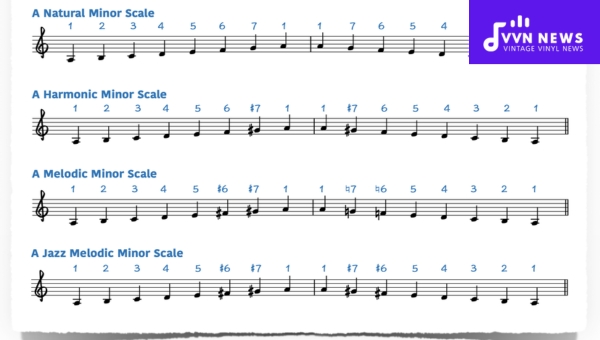
When they ascend, they make it sound like a natural minor scale by flattening the 6th and 7th degrees.
Conversely, while descending they raise the 6th and 7th degrees making it akin to a major scale.
- Ascending – C D Eb F G A B C
- Descending – C B A G F Eb D C
This duality creates a unique harmonic context contributing to an alluring sound that is inherently “Jazzy” in character.
FAQs
Why is a triad important in B flat major?
A triad, including the one in B Flat Major, forms the backbone of harmony in Western music.
What notes are in the B Flat Major triad?
In the B Flat Major triad, you’ll find these notes: B flat (Bb), D, and F.
How is a major triad formed?
A major triad is formed from a root note plus the third and fifth notes from its major scale.
Can I play the B flat Major triad on different instruments?
Yes, you can! The principles of forming and playing a triad remain the same across all instruments.
Why should I learn about the B flat Major Triad?
Familiarity with such foundational elements as the B flat Major Triad enables musicians for better melody, harmony, and chord progression.
Also Read: Understanding Music Transposition: A Complete Guide
Conclusion
Mastering the C melodic minor scale is a rewarding journey that will not only enhance your musical skill but also equip you with a unique tool for expressiveness and depth in your melodies.
As you delve deeper into music theory and practice regularly, the scale should become second nature to you.
Don’t stress too much about understanding every little detail at once, though; instead, adopt a progressive approach to internalizing these lessons.
